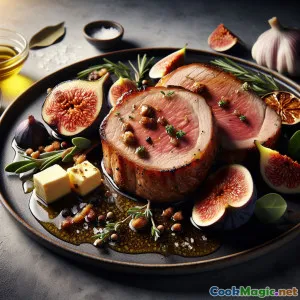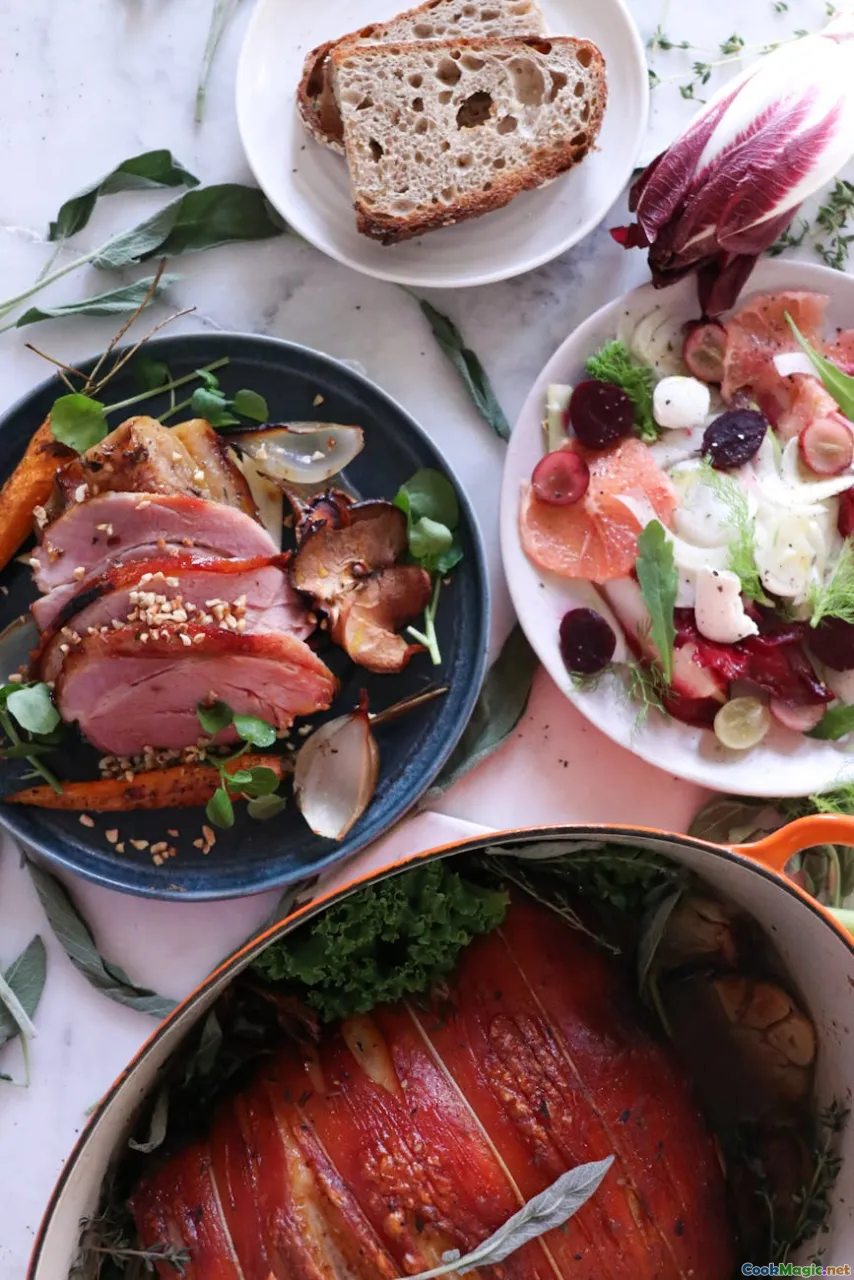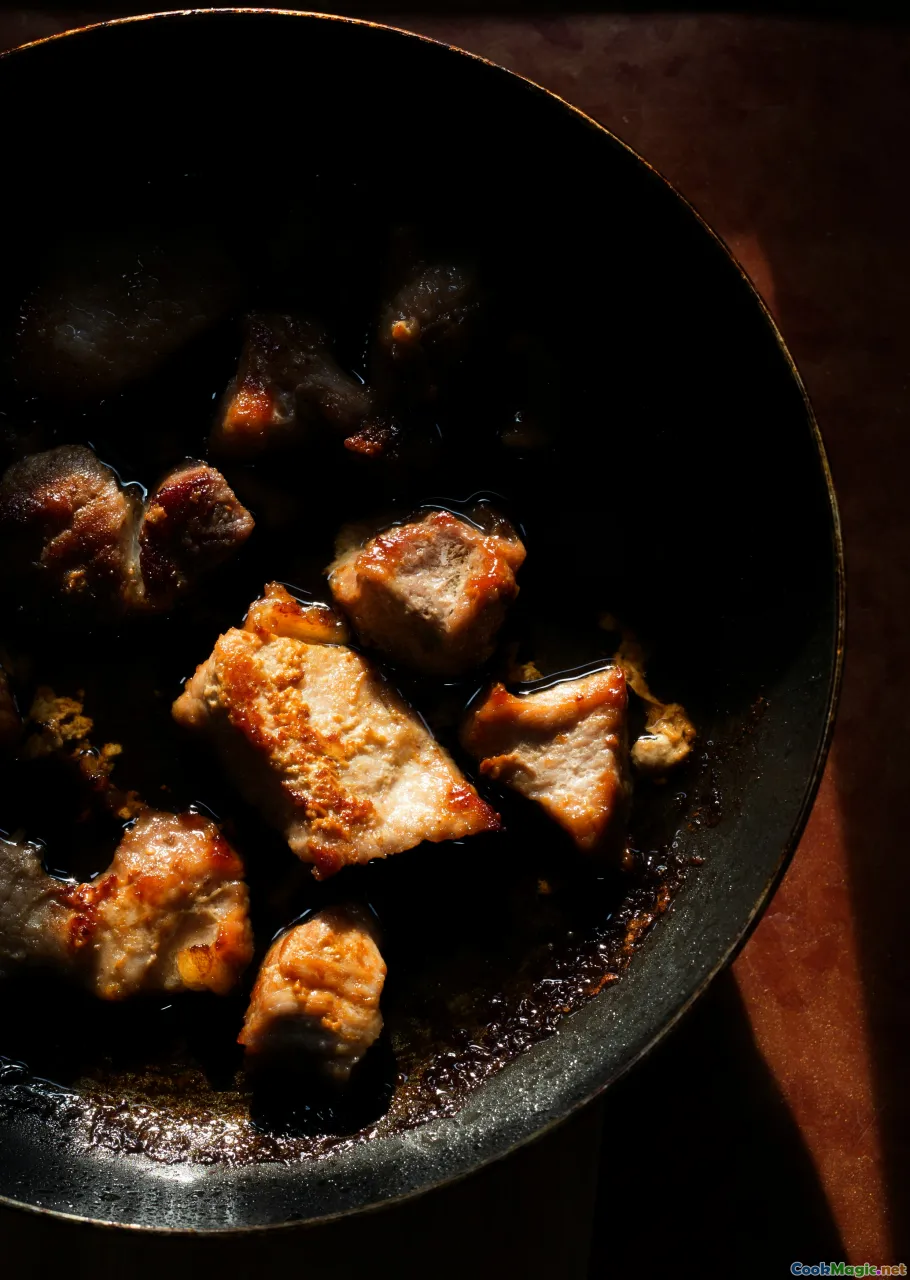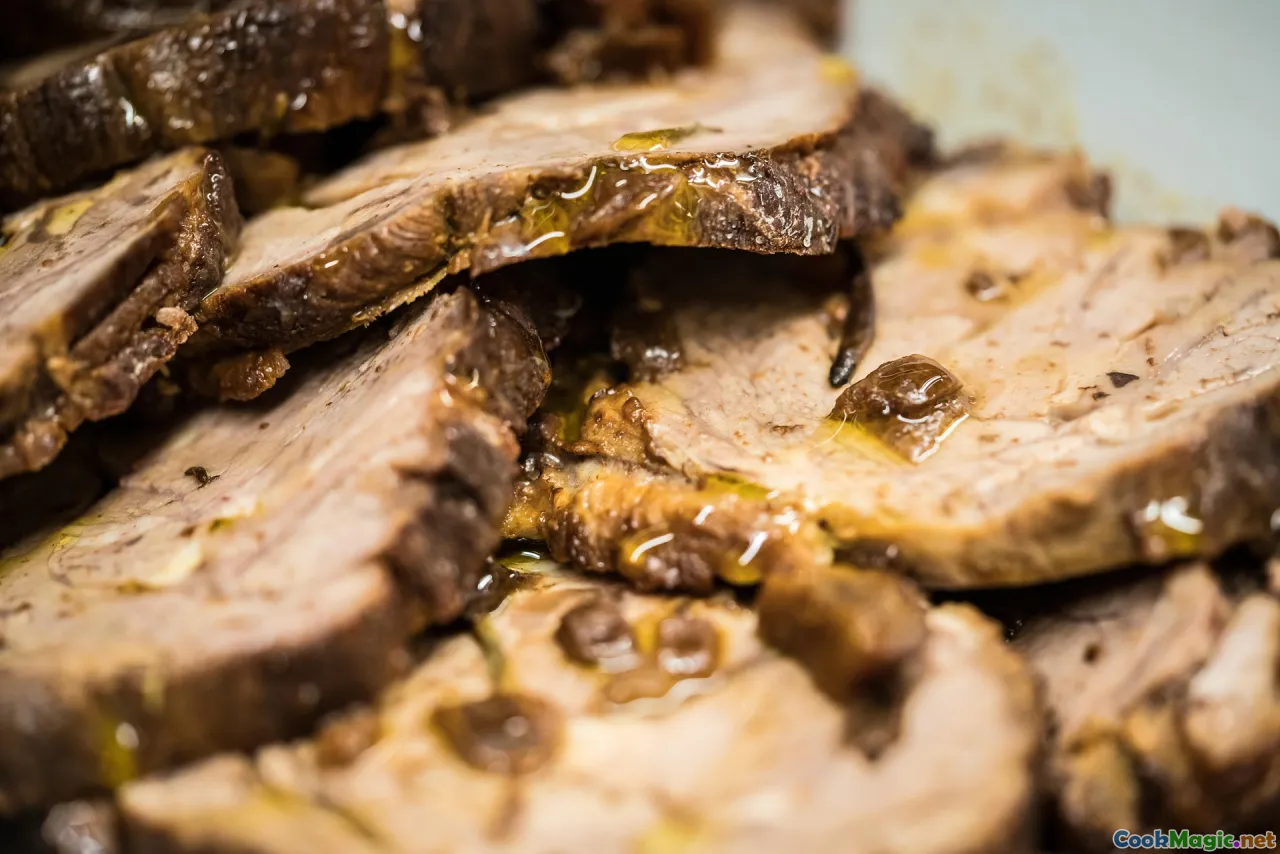
ظهر الخنزير بنكهة التين، صلصة Vermentinu
(Fig-Infused Pork Loin, Vermentinu Glaze)
(0 المراجعات)المكونات
-
900 grams لحم الخاصرة من الخنزير، مقطع مركزي، مُنظف
(Boneless; aim for an even cylindrical shape for even cooking)
-
10 grams ملح كوشير
(About 2 tsp; adjust to taste)
-
1 tsp فلفل أسود مطحون طازجًا
(Fine grind for even seasoning)
-
2 tbsp زيت الزيتون البكر الممتاز
(For searing and marinade)
-
120 grams تين مجفف، مفروم
(Mission or Calimyrna; stems removed)
-
8 pieces تين طازج مقطع إلى نصفين
(For roasting and garnish; choose firm-ripe)
-
3 cloves فصوص الثوم، مفرومة
(About 12 g)
-
2 tsp إكليل الجبل الطازج، مفروم ناعماً
(Or use 1 tsp dried)
-
1 tsp أوراق الزعتر الطازجة
(Stems discarded)
-
1 tsp بذور الشمر مطحونة بخفة
(Echoes Corsican flavors; crush to release aroma)
-
1 tsp قشر الليمون مبشور ناعماً
(Brightens the marinade)
-
1 tbsp عسل
(Balances wine acidity; use chestnut honey for Corsican flair)
-
1 tsp خردل ديجون
(Helps emulsify marinade and sauce)
-
360 ml Vermentinu (Vermentino) نبيذ أبيض
(60 ml for marinade, 300 ml for reduction)
-
200 ml مرق دجاج منخفض الصوديوم
(Adds body to the reduction)
-
28 grams زبدة غير مملحة، باردة ومقطعة إلى مكعبات
(About 2 tbsp; for mounting the sauce)
-
1 piece شَلوت مفروم ناعماً
(About 30 g)
-
1 piece ورقة الغار
(أزلها قبل التقديم)
-
1 tsp خل التفاح
(Optional acidity adjustment for the sauce)
-
0.5 tsp رقائق الملح البحري
(للتقديم النهائي)
-
0.5 tsp فلفل أسود مكسر
(للتقديم النهائي)
(Boneless; aim for an even cylindrical shape for even cooking)
(About 2 tsp; adjust to taste)
(Fine grind for even seasoning)
(For searing and marinade)
(Mission or Calimyrna; stems removed)
(For roasting and garnish; choose firm-ripe)
(About 12 g)
(Or use 1 tsp dried)
(Stems discarded)
(Echoes Corsican flavors; crush to release aroma)
(Brightens the marinade)
(Balances wine acidity; use chestnut honey for Corsican flair)
(Helps emulsify marinade and sauce)
(60 ml for marinade, 300 ml for reduction)
(Adds body to the reduction)
(About 2 tbsp; for mounting the sauce)
(About 30 g)
(أزلها قبل التقديم)
(Optional acidity adjustment for the sauce)
(للتقديم النهائي)
(للتقديم النهائي)
التغذية
- الحصص: 4
- حجم الحصة: 1 plated portion (250g)
- Calories: 520 kcal
- Carbohydrates: 24 g
- Protein: 45 g
- Fat: 22 g
- Fiber: 4 g
- Sugar: 18 g
- Sodium: 780 mg
- Cholesterol: 120 mg
- Calcium: 60 mg
- Iron: 2.8 mg
التعليمات
-
1 - Build the fig-herb marinade:
In a bowl, combine dried figs, rosemary, thyme, fennel seeds, garlic, lemon zest, honey, Dijon (if using), 60 ml Vermentinu, 1 tbsp olive oil, and a pinch of salt and pepper. Mash lightly with a fork to form a chunky paste.
-
2 - Season and marinate the pork:
Pat the pork loin dry. Rub all over with kosher salt and pepper, then coat with the fig marinade, pressing it onto the surface. Cover and refrigerate 2–12 hours for best infusion (or proceed immediately if short on time).
-
3 - Preheat and Prepare:
Preheat oven to 200°C (390°F). Set a heavy oven-safe skillet or roasting pan over medium-high heat. Wipe most marinade from the surface of the pork, reserving any that falls off for the pan.
-
4 - Sear the pork:
Add remaining 1 tbsp olive oil to the hot pan. Sear pork on all sides until deep golden, about 1–2 minutes per side. Transfer to a plate; pour off excess fat if needed.
-
5 - Roast with fresh figs:
Return pork to the pan. Nestle fresh fig halves cut-side up around it. Roast until internal temperature reaches 60–63°C (140–145°F), about 20–28 minutes depending on thickness.
-
6 - Rest the meat:
Transfer pork to a board and tent loosely with foil to rest. This allows juices to redistribute and temperature to coast to 63–65°C (145–150°F).
-
7 - Build the Vermentinu reduction:
Set the roasting pan over medium heat. Add minced shallot; sauté 1 minute in pan drippings. Deglaze with 300 ml Vermentinu, scraping fond. Add chicken stock and bay leaf; simmer briskly until reduced by about half.
-
8 - Finish and balance the sauce:
Remove bay leaf. Off heat, whisk in cold butter to emulsify. Taste; adjust with a pinch of salt and, if needed, 1 tsp apple cider vinegar to brighten. Return to very low heat if necessary to keep warm without boiling.
-
9 - Slice and plate:
Slice pork into 1–1.5 cm medallions. Spoon Vermentinu reduction onto warm plates, fan slices over the sauce, and add roasted figs. Finish with sea salt flakes and cracked pepper.
In a bowl, combine dried figs, rosemary, thyme, fennel seeds, garlic, lemon zest, honey, Dijon (if using), 60 ml Vermentinu, 1 tbsp olive oil, and a pinch of salt and pepper. Mash lightly with a fork to form a chunky paste.
Pat the pork loin dry. Rub all over with kosher salt and pepper, then coat with the fig marinade, pressing it onto the surface. Cover and refrigerate 2–12 hours for best infusion (or proceed immediately if short on time).
Preheat oven to 200°C (390°F). Set a heavy oven-safe skillet or roasting pan over medium-high heat. Wipe most marinade from the surface of the pork, reserving any that falls off for the pan.
Add remaining 1 tbsp olive oil to the hot pan. Sear pork on all sides until deep golden, about 1–2 minutes per side. Transfer to a plate; pour off excess fat if needed.
Return pork to the pan. Nestle fresh fig halves cut-side up around it. Roast until internal temperature reaches 60–63°C (140–145°F), about 20–28 minutes depending on thickness.
Transfer pork to a board and tent loosely with foil to rest. This allows juices to redistribute and temperature to coast to 63–65°C (145–150°F).
Set the roasting pan over medium heat. Add minced shallot; sauté 1 minute in pan drippings. Deglaze with 300 ml Vermentinu, scraping fond. Add chicken stock and bay leaf; simmer briskly until reduced by about half.
Remove bay leaf. Off heat, whisk in cold butter to emulsify. Taste; adjust with a pinch of salt and, if needed, 1 tsp apple cider vinegar to brighten. Return to very low heat if necessary to keep warm without boiling.
Slice pork into 1–1.5 cm medallions. Spoon Vermentinu reduction onto warm plates, fan slices over the sauce, and add roasted figs. Finish with sea salt flakes and cracked pepper.
المزيد عن : ظهر الخنزير بنكهة التين، صلصة Vermentinu
Fig-Infused Pork Loin with Vermentinu Reduction
This dish celebrates the sun-warmed flavors of the Mediterranean through a Corsican lens: lean, tender pork loin, perfumed with figs and wild herbs, then glossed with a bright, aromatic Vermentinu reduction. The interplay is all about balance — the subtle sweetness of figs, the resinous lift of rosemary and thyme, the anise whisper of fennel seed, and the crisp, citrusy backbone of the Vermentinu wine.
Why this recipe works
- Figs as flavor carriers: Dried figs are gently mashed into a paste that clings to the pork, acting like a moisture-retaining blanket while infusing earthy sweetness. Fresh figs roast alongside, concentrating their sugars and providing a lush garnish.
- Sear then roast: A quick sear builds savory depth and color; finishing in the oven ensures even doneness without drying the lean loin.
- Vermentinu reduction: Vermentinu (Corsican for Vermentino) is naturally aromatic with citrus zest, pear, and herbal notes. Reducing it with shallot and stock yields a sauce that is elegant, not heavy, perfectly aligned with the delicate pork.
Cultural touchstone
Corsica, an island with rugged mountains and maquis-scented hillsides, has a proud identity and a cuisine that leans into wild herbs, chestnut honey, and pristine wines. Vermentinu is a signature grape there, producing lively whites that love both seafood and pork. Figs — cultivated across the Mediterranean for millennia — feature prominently in Corsican preserves and pastries, and pair beautifully with pork. This recipe nods to that heritage while remaining approachable for a home kitchen.
Ingredient notes and swaps
- Pork loin vs tenderloin: This recipe targets a center-cut loin, which is larger than tenderloin. If using tenderloin, reduce roasting time significantly (often 12–18 minutes after sear) and consider halving the sauce.
- Wine choices: If Vermentinu is unavailable, choose Vermentino from Sardinia or Liguria, or a similarly brisk, aromatic white such as Picpoul, Albariño, or a stainless-steel Sauvignon Blanc.
- Sweetness level: Dried figs vary in sugar. Taste the sauce before finishing and adjust with a touch of vinegar for balance. Chestnut honey brings a gentle bitterness that elevates complexity.
- Herbs and spice: Fennel seed is classic with pork. If you prefer a woodier profile, add a light pinch of crushed juniper or a bay leaf to the marinade.
- Gluten-free: The reduction is naturally gluten-free. If you want extra viscosity, a tiny slurry of cornstarch can be whisked in before mounting with butter.
Technique tips
- Patience with the sear: Let the pork release naturally from the pan; if it sticks, give it another 30 seconds. Deep browning equals deeper flavor in both meat and sauce.
- Temperature control: Aim for 63–65°C final temperature. Carryover during resting will finish the job while keeping the loin juicy.
- Deglaze deliberately: Add the wine in two additions if your pan is very hot, reducing flare-ups and allowing more thorough fond dissolution.
- Sauce texture: Mount with cold butter off heat to keep the emulsion satiny. If it breaks, whisk in a splash of hot stock to bring it back together.
Make-ahead and storage
- The loin can be marinated up to 12 hours ahead. Remove from the fridge 30 minutes before cooking to temper.
- Leftovers keep well for 3 days, sliced and stored with a spoonful of sauce. Gently reheat covered at low heat or serve room temperature over greens with a drizzle of olive oil and lemon.
Plating and pairing
Cut medallions on a bias and pool the golden reduction beneath so the crust stays crisp. Scatter roasted fig halves and a sprig of rosemary. Pair with a chilled glass of Vermentinu, of course, or a dry rosé from Corsica or Provence. For sides, consider polenta, crushed new potatoes with olive oil and herbs, or a peppery salad of arugula and shaved fennel.
Troubleshooting
- Sauce too sweet: Add a pinch of salt and a few drops of cider vinegar or lemon juice; reduce a bit further to intensify acidity.
- Pork looks pale: Your pan may have been underheated or crowded. Next time, ensure the pan is properly preheated and avoid moving the loin during the first minute of searing.
- Dry texture: Overcooking is the usual culprit. Use a probe thermometer and pull at 60–63°C before resting.
Sustainability and sourcing
Choose responsibly raised, local pork when possible. Seek out dried figs without added sugars and wines from producers who practice sustainable viticulture. These choices often translate into purer flavors and better outcomes in the pan.
Final thoughts
This recipe is about honoring simple, high-quality ingredients and letting them converse on the plate. The figs do not overwhelm; they harmonize. The wine reduction carries the melody — bright, herbal, and citrus-lined — while the pork provides the bass notes. Whether for an autumn dinner party or an intimate weekend meal, Fig-Infused Pork Loin with Vermentinu Reduction delivers elegance with comforting familiarity, and a taste of Corsican sunshine in every bite.

























